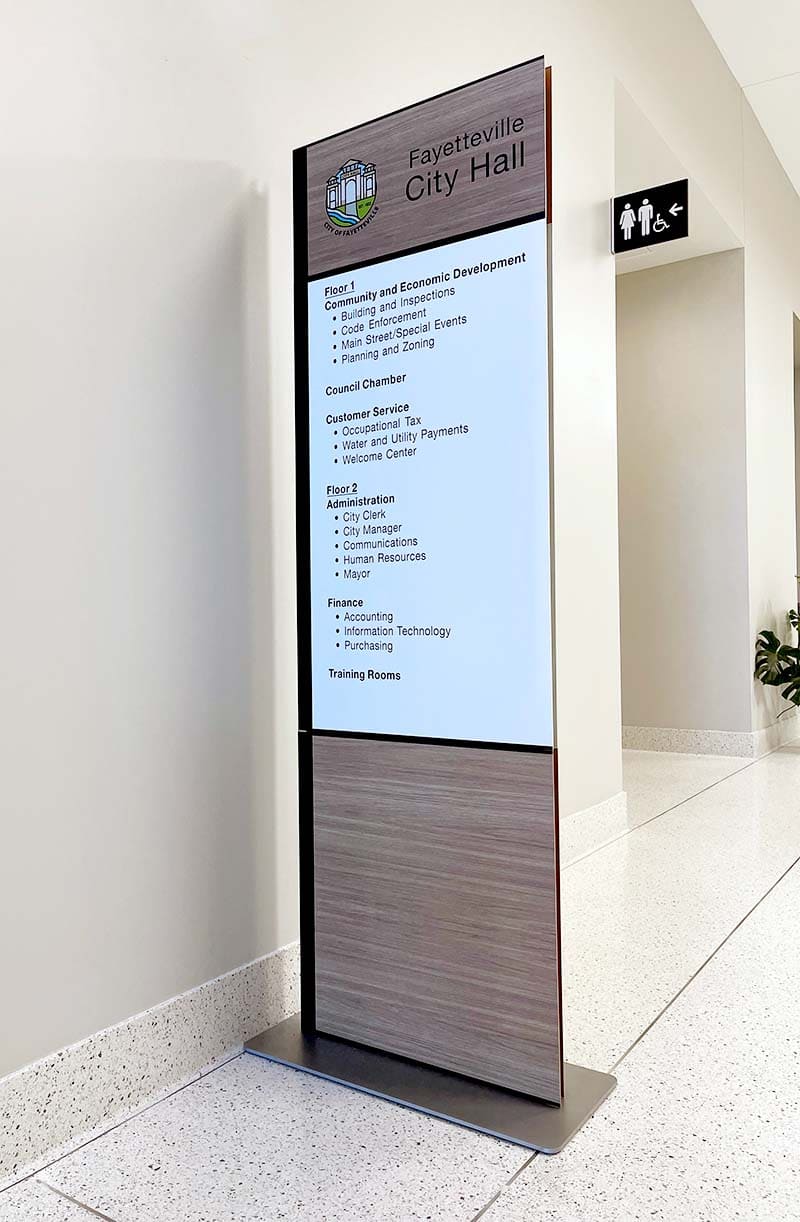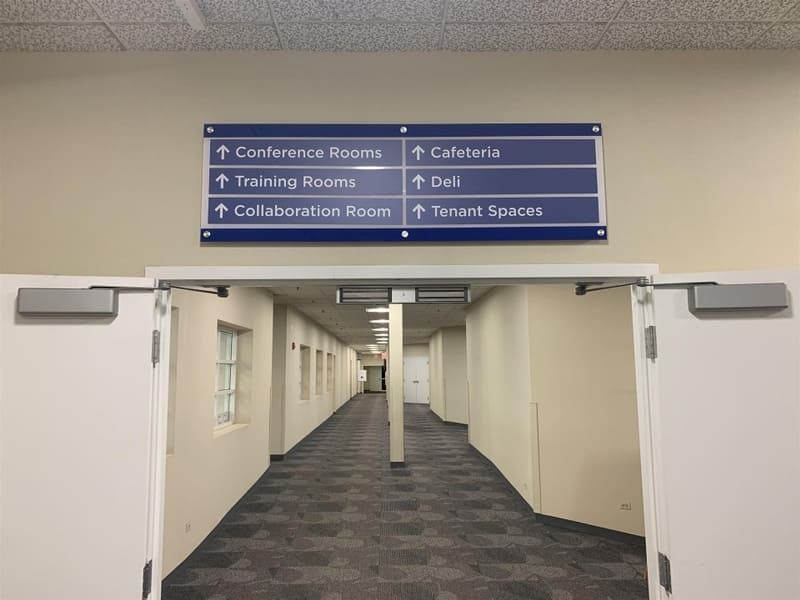Government agencies fall under unique scrutiny when communicating with the public. Government buildings must project an air of modern sophistication to inspire public confidence in local government and ensure that government facilities are inclusive and accessible to all citizens. Clear, effective government signage can help agencies better support the needs of the public while remaining compliant with critical accessibility standards and guidelines. The key is working with a company that can create signage that fits the unique needs of your municipality.
What is Government Signage?
Government signage refers to the various types of signs used in government buildings and public spaces to provide information, directions, and safety instructions to citizens. These signs are crucial for ensuring that public spaces are navigable, accessible, and welcoming to all individuals, regardless of their abilities or familiarity with the area. Government signage must meet specific standards to ensure readability, visibility, and accessibility.
City Halls
City halls are the administrative centers of municipalities, where citizens come for various services such as permits, licenses, and public meetings. Effective signage in city halls includes directories, office signs, and wayfinding signs to guide visitors to the appropriate departments and offices.
Courthouses
Courthouses require clear and precise signage to help visitors navigate the complex layout of courtrooms, clerk offices, and legal services. Signage in courthouses often includes directional signs, room numbers, and informational signs about court procedures and schedules.
Post Offices
Post offices are essential facilities where citizens access mailing and shipping services. Signage in post offices includes service counter signs, informational signs about postal services and rates, and wayfinding signs to help customers find PO boxes and service areas.
Government Offices
Various government offices, such as social services, public health, and employment agencies, require signage to assist visitors in finding their way and understanding available services. These signs include department directories, service counter signs, and informational posters about available programs and assistance.
Public Safety Buildings
Public safety buildings, including police stations, fire stations, and emergency services, need signage to direct citizens to emergency services, administrative offices, and public meeting areas. Clear and visible signage is crucial for quick and efficient access to public safety resources.
Parks and Recreation Facilities
Parks and recreation facilities benefit from signage that helps visitors navigate trails, find facilities such as restrooms and picnic areas, and understand park rules and regulations. Informational signs about local wildlife, history, and natural features enhance the visitor experience.
Maintenance Facilities
Maintenance facilities, where municipal workers manage public infrastructure and services, require signage for safety and organization. Signs in these facilities include safety warnings, equipment labels, and directional signs to various work areas and storage locations.
Parking Structures
Parking structures associated with government buildings need clear signage to direct drivers to available parking, exits, and pedestrian access points. Signage in parking structures also includes information about parking fees, hours of operation, and accessibility features.
What are Some Examples of Government Signs?
Government signage comes in various forms, each serving a specific purpose in guiding, informing, and protecting the public. Here are some common types of government signs:
Signes de lettre de canal
Channel letter signs are three-dimensional signs often used on the exterior of government buildings to display the building’s name or department. These signs are highly visible and can be illuminated for better nighttime visibility. Channel letter signs convey professionalism and make it easy for citizens to identify government facilities from a distance.
Wayfinding Signs
Wayfinding signs are essential for guiding visitors through government buildings and public spaces. These signs include directional arrows, maps, and directories that help people find their way to offices, service counters, meeting rooms, and other important locations. Effective wayfinding signage reduces confusion and improves the overall experience for visitors.
Monument Signs
Monument signs are freestanding signs placed at the entrances of government properties, such as city halls, courthouses, and parks. These signs are typically large and designed to make a strong visual impact. Monument signs provide essential information about the facility and help establish a sense of place and importance.
Post and Panel Signs
Post and panel signs are versatile and can be used both indoors and outdoors for various purposes, including directional signage, informational signs, and regulatory signs. These signs consist of a panel mounted between two posts and can be customized with text, graphics, and logos to match the specific needs of the government facility.
The Importance of Accessibility in Government Signage
Accessibility is a critical consideration for government signage. Signs must be designed to be readable and understandable by all individuals, including those with visual, hearing, or cognitive impairments. Here are some ways government signage enhances accessibility:
Compliance with ADA Standards
Government signage must comply with the Americans with Disabilities Act (ADA) standards, which include requirements for text size, font, contrast, and placement. ADA-compliant signs ensure that individuals with disabilities can access and understand important information.
Braille and Tactile Elements
Including Braille and tactile elements on signs helps visually impaired individuals navigate government buildings. These features provide essential information that can be read by touch, making public spaces more inclusive.
High Contrast and Legible Fonts
Using high contrast between text and background, along with legible fonts, improves readability for individuals with low vision or cognitive impairments. Clear and simple signage design enhances comprehension for all visitors.
The Role of Digital Signage in Government Buildings
Digital signage is becoming increasingly popular in government buildings due to its versatility and ability to provide real-time information. Here are some benefits of using digital signage:
Real-Time Updates
Digital signs can be easily updated to provide real-time information about events, schedules, and important announcements. This feature is particularly useful for emergency notifications and last-minute changes.
Interactive Kiosks
Interactive kiosks allow visitors to access information, maps, and directories through touch screens. These kiosks can provide a wealth of information and enhance the visitor experience by offering self-service options.
Dynamic Content
Digital signage can display dynamic content such as videos, animations, and slideshows, making the information more engaging and easier to understand. This feature is ideal for public awareness campaigns and educational messages.
Integrating Signage with Public Communication Strategies
Effective government signage should be integrated into broader public communication strategies to ensure consistency and reinforce key messages. Here are some ways to achieve this integration:
Consistent Branding
Using consistent branding across all signage and communication materials helps establish a recognizable and professional image for the government agency. This consistency builds public trust and reinforces the agency’s identity.
Multi-Channel Communication
Signage should be part of a multi-channel communication strategy that includes online platforms, social media, and printed materials. This approach ensures that messages reach the public through various channels and are reinforced across different media.
Public Feedback
Gathering feedback from the public about signage effectiveness can help identify areas for improvement. Regularly updating and refining signage based on public input ensures that it meets the needs of the community.
Conclusion
Government signage plays a crucial role in ensuring that public spaces are accessible, navigable, and welcoming to all citizens. By investing in high-quality, effective signage, government agencies can enhance communication, improve accessibility, and build public confidence. Whether through traditional signs or digital displays, the right signage solutions can make a significant difference in the functionality and inclusiveness of government facilities. Partnering with a trusted signage provider ensures that all signage meets the highest standards of design, compliance, and effectiveness, ultimately supporting the agency’s mission to serve the public effectively.








Laissez un commentaire